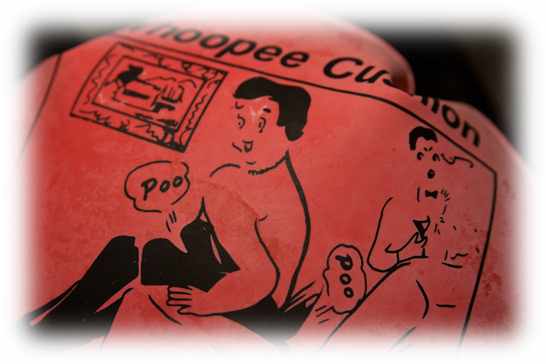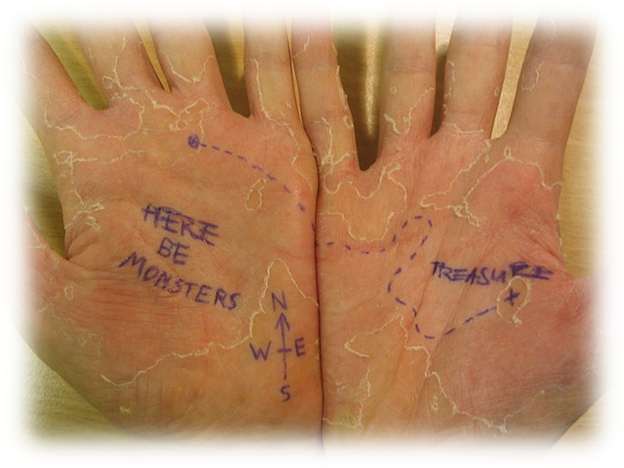An interview with first time children’s author and illustrator Luke Carr

I met Luke mid way round the Tough Mudder course covered in mud and dressed as Luigi from Mario Brothers. It wasn’t until a month later as I discovered that not only is he a very talented illustrator, but he’s also just written and self-published a children’s book!
Luke’s book, Eric the Dragon (remember your manners), has been illustrated and written by himself from scratch.
I caught up with Luke on a Skype video call earlier this week and asked him a few questions about his book, how he came up with the idea (and why) and how he went about getting it printed and into the hands of parents at a local school open day.
Luke is 20 something, lean and obviously goes to the gym regularly. The view of his office/room that the Skype video call gives me shows a large-ish room with the same Ikea furniture that I have and walls covered in drawings and scribbles from the world of comics and his own imagination.
I get the feeling that he and I are going to get along very well.
After a bit of a catch up and discussion about our respective Mudder experiences and whether we’ve been foolish enough to sign up for another (I’m doing one in July and Luke’s probably doing one in November, so : yes we are foolish enough), we start talking about the book (or books as it turned out).
Luke works part time at a local stationer (handy for discounted pencils and art materials!) and part time producing illustrations for a company in Holland along with a bit of graphic design, in which he has a degree, for companies wanting logos etc.
—
Ben : So tell us about the book.
Luke : So the first book is finished and that’s gone to print and it’s about Eric the Dragon. And the whole series of books is about kids and bite size lessons. Throughout the story [and indeed all the series as Luke showed me], none of the characters are coloured in.
The idea is to get the children to interact with it and get their colouring pencils out. The way I see it, the more interactive it is, the more likely it is they will remember the lessons.
Ben : Did you do the story as well as the illustration?
Luke : Yeah, I’ve done all of it myself. That’s why it took so long to do!
Ben : How long did it take?
Luke : I’ll be honest, the first picture of Eric the Dragon that I drew wasn’t for the book, it was for a T-shirt design.

Ben : So how did Eric get from T-shirt design to the book?
Luke : He was going to be the spear for a load of canvases about three years ago. All about staying young in the head and try to be young and youthful. Life’s a bit too serious sometimes and [Eric] was a split second idea that kind of popped into my head.
Ben : So did [the book] start out being about manners?
Luke : When I put him in the book, I straight away went to “how can I put him in a book? What would be the theme?” It was always going to be for children, but it probably came from my Granddad : My Granddad always used to say to me “manners maketh the man” and in this day and age you’ve got so many kids out there that don’t really get taught and end up as little toe rags. I just thought if I could get the book out to just a handful of children and they learnt something, that’s good.
Ben : Where did you get the inspiration for the books?
Luke : I have a Tips4Tots book [Luke’s own brand for his children’s books which can be found at www.tips4tots.co.uk]. This is where I put everything : Brainstorming, logo ideas… If I start talking about it and people start giving me ideas, then I start putting them in here. It’s nice to look back and see ideas.
A good bit of inspiration came from the Mr Men books. I think that’s what urged me to make them square. I know it’s like a tiny detail but I used to work at Wilkinson’s and we had a stand full of the Mr Men books and it was really cool to see all the Mr Men books lined up on this spiny turnstyle thing and there was something really cool and it made you want to collect them all.
So the idea for the book is each book is going to be colour coded. So the first one’s green and the next one, along the top, will be “Oliver the Crocodile” and the paint splat behind will be a different colour. So they’ll all be colour coded but they’ll keep the same set up. I drew that from the Mr Men books as well. For me the Mr Men books are very popular. Still! So I wanted to mimic that in a way as well.
When I got the first prints I went into Wilkinson’s and propped them up on the shelf just to see how it looked in the environment it’s going to be in and yeah… It worked. I could just imagine a series of books all different colours but all kind of had the same style. It put a big smile on my face. A big smile on my face!
Ben : What kind of research did you do?
Luke : I was very nieve about it. I just jumped in the deep end and said “let’s make a book.” And then I learnt lessons as I came to the obstacles. Like when I came to the printers to get quotes : they were like “we deal in multiples of 24” or something etc. Then I did some test prints and the bleed line wouldn’t set up properly so pages would be cut off and stuff.
I was like a kid : you give ‘em paints and they don’t stand there putting their apron on and stuff, they jump straight in and get involved! I’m still learning now.
I’ve got little nieces and they did my little trials : I’d FaceTime them and show them stuff and they’d give me a response because I branded the series “Tips4Tots”, so anything I did, I put it past those two and they were awesome they just… Ah children’s English is just different at feedback. They’re better at that, very simple : If they don’t like something they say “nah, no” or if they like something then they want it broken down.
It’s my first book and things will change, but I need to keep that child mentality. The artwork, the artwork is very simple : children look at artwork like that. They like it, they like the little details.
I draw all the time and with the book it’s nice to… It’s not just a picture on the computer : I have a book I can hold now. I have a book I can hand to people and like I said : if it works, it works if it doesn’t, at least I’ve tried.
Ben : So if you don’t mind me asking, how much did it cost?
Luke : For the first set of fifteen books for the [school] open day it was just over fifty pounds [about £3.50 per book] and that was a bargain ‘cause I got quotes on line from different companies and online, the cheapest quote I got for the same amount was just shy of two hundred pounds! When I got the quotes back I was like “£200 for 15 books!!?”
I start thinking in the long run like if I want to mass-produce these things… But then shopping around I found a local printers in Nottingham called John E Wright.
Ben : How did you end up promoting your book at a local school?
Luke : It was all from the stationary shop actually, where I work. A teacher kept coming in and I got talking to her and I managed to get a place on this open day. So I went down, set up my stall and promoted my book. The feedback I got was awesome. Really good.
Ben : What sort of feedback have you had so far?
Luke : I was told by one of the teachers [at the school open day] not to use the word “naughty” in my book. That’s apparently not good. I didn’t know that and to me, its… I don’t see a problem with it.
Ben : Wow that’s a classic word! What do they use to describe a naughty child now!?
Luke : She said “You’re not being sensible”. That was one of them. I can’t remember what the other was.
Ben : So what would you do differently for the next one?
Luke : Again, I’m going to wait for the feedback from the first book. The best thing about it this time is that because the layout’s all set up so it’s 7” by 7” squared, so when I do all the artwork and stuff it’s very much… it’ll be faster, which will give me more time to focus on the quality.
Every two page spread I do, I’ll take that to a group of children rather than just rely on my two little nieces just to get feedback.
At the end of the day, I’m not in it to make a load of money. I’d be lying if I said I wasn’t in it to make a bit of money but it would help future projects. I like the idea of… I wouldn’t say “helping children”… but giving them a product that maybe helps them in an area. Not like life changing things, just… I don’t know, if they read the book and colour it in and then parents start hearing their kids saying “please” and “thank you” more then that’s mission accomplished. That’s wicked and that’s what I’m all about. And if children brush their teeth more because they’ve read the second book…
Ben : So what’s next?
Luke : It’s getting super busy at the minute, holding a job down and doing this book and doing all the graphic design and illustration for this company in Holland it’s very hard to find time to… take a bit of time to research more. I’m not on a timeframe and I don’t have anybody saying “this book has to be done by this time”.
Maybe that would be a blessing in disguise because the other companies I work for give me deadlines to get it done and because it needs to get done; it gets done. The book and the other one is on the backburner.
Book number two is Oliver the Crocodile (Look After Your Teeth), teaching kids how to look after their teeth and the third book will be the Big Bear, remember to share. Nothing too deep and then the other ones that are big at the moment like recycling.
The thing that pushed me to really get it done is the teacher who got me a spot at this promotion day the other day. It was a couple of months ago and she said “I’ve spoken to the committee and they want you to come and promote your book.” I was like Wohaa! Right! Two months, so let’s do it! And I spent a lot of time drawing and
Ben : Thanks a lot Luke and good luck!
Luke : It’s been a pleasure and I’ll speak to you in the near future.
—
Luke is working on making online purchases of Eric the Dragon available, but in the mean time, if you’d like a copy, head over to www.tips4tots.co.uk and send him an email and he’ll let you know when the next batch are being printed and what it will cost you for a copy.




